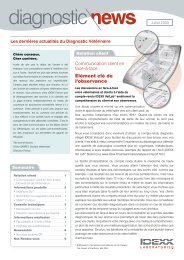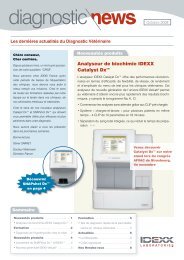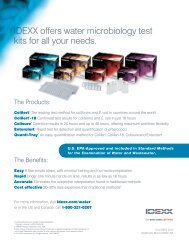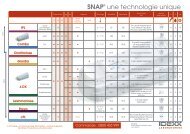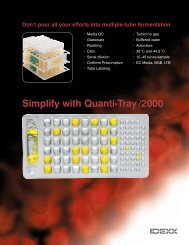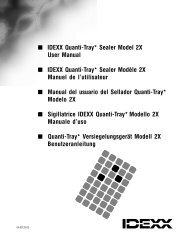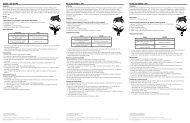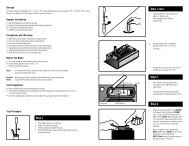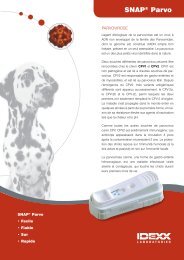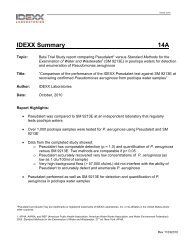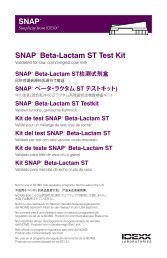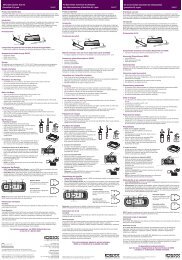Colilert-250 Technical Note 16A - IDEXX Laboratories
Colilert-250 Technical Note 16A - IDEXX Laboratories
Colilert-250 Technical Note 16A - IDEXX Laboratories
Create successful ePaper yourself
Turn your PDF publications into a flip-book with our unique Google optimized e-Paper software.
The <strong>Colilert</strong> <strong>250</strong> presence/absence method uses the <strong>IDEXX</strong> patented Defined Substrate Technology*(DST*) to simultaneous detect of E. coli and total coliform bacteria in <strong>250</strong>mL volumes of drinking andbottled water samples after 24 – 28 hours of incubation at 36°C ± 2°C. The two nutrient‐indicators, o‐nitrophenyl‐β‐D‐galactopyranoside (ONPG) and 4‐methylumbelliferyl‐ β‐D‐glucuronidase (MUG) are theprimary nutrients in <strong>Colilert</strong> and can be metabolized by the total coliform enzyme β‐galactosidase andthe E. coli enzyme β‐glucuronidase, respectively. As total coliform bacteria grow in <strong>Colilert</strong>, they use theenzyme β‐galactosidase to metabolize ONPG and change the reagent from colorless to yellow (seeFigures 1a and 1b). As E. coli grow in <strong>Colilert</strong>, they use the enzyme β‐glucuronidase to metabolize MUGand create fluorescence when placed under 365‐nm ultraviolet (UV) light (see Figures 2a and 2b). The<strong>Colilert</strong> <strong>250</strong> presence/absence method is also specifically formulated to selectively suppress the fewnon‐E. coli and non‐total coliform bacteria that have the β‐galactosidase and β‐glucuronidase enzymespresent.Figure 1a Figure 1bFigure 2a Figure 2bBottled Water Sample TypesMethodThe thirty bottled water samples included in this study originated from twelve different countriesaround the world and were made up of the following bottled water types – spring water brands,artesian water brands, drinking water brands, still mineral water brands, and sparkling mineral waterbrands (Table 2). <strong>Colilert</strong> <strong>250</strong> requires that sparkling water types be thoroughly degassed prior totesting. Therefore, all sparkling bottled water samples were manually degassed, by shaking, prior totesting.Table 2Bottled Water types, total number of brands and geographical locations used in this studyTotal # ofwatersTotal # ofbrandsWater source locationBottled Spring 9 6 4 x USA 3 x France 1 x Iceland 1 x ScotlandBottled Artesian 8 5 3 x Croatia 3 x New ZealandBottled Drinking 7 5 7 x USA2 x South PacificIslandsBottled Sparkling Mineral 5 5 1 x Germany 3 x Italy 1 x United KingdomBottled Still Mineral 1 1 1 x United KingdomTotals 30 22
Analytical MethodsIt is optimal, whenever possible, to use natural samples with the target organisms when comparingmethods. Due to the limited availability of bottled water samples containing E. coli and total coliformbacteria, it was necessary to perform the comparison by the inoculation of relevant target andnon‐target reference organisms into the water matrix in question. ISO/CD 11133:2009 was used asguidance when selecting the target and non‐target organisms for the spike challenge study (Table 3).Quality control strains listed in Annex F, Table F 3 of the ISO/CD 11133:2009 were included, along withother relevant strains listed within the ISO/CD 11133:2009 document. Pure cultures of the referencestrains were sourced from American Type Culture Collection (ATCC) and were analyzed by bioMérieux’sVITEK 2 system prior to use (Appendix B, Table B‐1).The target organism panel consisted of 9 relevant organisms; 3 strains of E. coli and 6 strains of totalcoliform bacteria. Each organism was inoculated into a bottled water sample at a concentration of1 – 15 cfu / <strong>250</strong>mL. Each bottled water sample was then split and analyzed in duplicate using the <strong>Colilert</strong><strong>250</strong> presence/absence method and the reference method ISO 9308‐1:2000(E).The non‐target organism panel consisted of 6 relevant organisms; 6 strains of common, non‐E.coli,non‐coliform, gram positive and gram negative water bacteria. Non‐target organisms were inoculatedinto a bottled water sample as a cocktail, each at a concentration of 10 ‐ 50 cfu / 1mL for a total of<strong>250</strong> cfu / 1mL. Each bottled water sample was then split and analyzed in duplicate using the <strong>Colilert</strong> <strong>250</strong>presence/absence method and the reference method ISO 9308‐1:2000(E).Table 3Reference strains of E. coli, total coliform and non‐targets selected for pure culture spikeBacterium Source RelevanceEscherichia coli ATCC 9 11775 10 <strong>IDEXX</strong> recommended QC 11 Strain10 <strong>IDEXX</strong> recommended QC Strain ;Escherichia coli ATCC 25922QC Strain for ISO 9308‐1 (ISO 11133:2009)Escherichia coli ATCC 8739 QC Strain for ISO 9308‐1 (ISO 11133:2009)Klebsiella pneumoniae ATCC 13883<strong>IDEXX</strong> recommended QC Strain ;QC Strain for ISO 9308‐1 (ISO 11133:2009)Enterobacter aerogenes ATCC 13048 QC Strain for ISO 9308‐1 (ISO 11133:2009)Enterobacter cloacae ATCC 13047 Listed in ISO 11133:2009Citrobacter freundii ATCC 43864 Listed in ISO 11133:2009Klebsiella oxytoca ATCC 13182 Relevant total coliformHafnia alvei ATCC 13337 Listed in ISO 11133:2009Enterococcus faecalis ATCC 29212 QC Strain for ISO 9308‐1 (ISO 11133:2009)Staphylococcus aureus ATCC 25923 QC Strain for ISO 9308‐1 (ISO 11133:2009)Pseudomonas aeruginosa ATCC 27853 10 QC Strain for ISO 9308‐1 (ISO 11133:2009)Aeromonas hydrophila ATCC 7966 Listed in ISO 11133:2009Bacillus licheniformis ATCC 14580 Listed in ISO 11133:2009Pseudomonas putida ATCC 12633 Listed in ISO 11133:20099. American Type Culture Collection (ATCC)10. ATCC 11775, ATCC 25922, and ATCC 27853 are listed as quality control organisms in the <strong>Colilert</strong> <strong>250</strong>* insert11. Quality Control (QC)
<strong>Colilert</strong> <strong>250</strong> presence/absence method was performed as described in the supplied product insert.As previously described, each inoculated bottled water sample was split between the two methods.For <strong>Colilert</strong> <strong>250</strong>, duplicate <strong>250</strong>mL samples were dispensed into <strong>IDEXX</strong> sterile plastic 290mL vessels and ablister pack of <strong>Colilert</strong> <strong>250</strong> medium was added to each vessel. <strong>Colilert</strong> <strong>250</strong> samples were agitated untilmedium was completely dissolved and then placed into an air‐circulating incubator set at 36°C ± 1°C.<strong>Colilert</strong> <strong>250</strong> samples were observed for color and fluorescence under a 365nm UV lamp after 24 and 28hours of incubation. After the 28 hour observation all <strong>Colilert</strong> <strong>250</strong> samples, positive and negative, wereconfirmed by the confirmation methods listed in Appendix A, Flowcharts A‐1 & A‐2.Reference method ISO 9308‐1:2000(E) was performed according to the Standard Test method describedin the related ISO documentation. As previously described, each inoculated bottled water sample wassplit between the two methods. For ISO 9308‐1:2000(E), duplicate <strong>250</strong>mL samples were concentrated bymembrane filtration, membrane was carefully placed on the Lactose TTC agar and finally agar plateswere placed into an air‐circulating incubator set at 36°C ± 1°C. Samples were observed after 21±3 hoursand lactose‐positive bacteria were counted and confirmed through the Oxidase and Indole confirmationtests described in ISO 9308‐1:2000(E). The confirmed ISO 9308‐1:2000(E) membrane filtration count wasused to determine the actual E. coli or total coliform inoculum during testing.Statistical AnalysisThe confirmed ISO 9308‐1:2000(E) membrane filtration count was used to determine the actual E. coli ortotal coliform inoculum, only data sets with an average count falling between 1‐15 cfu / <strong>250</strong>mL wereused in the data analysis. Once used for the determination of actual inoculum, the ISO 9308‐1:2000(E)quantitative data sets were converted to presence/absence data sets so that they could be directlycompared to the <strong>Colilert</strong> <strong>250</strong> presence/absence data sets. Finally, all the <strong>Colilert</strong> <strong>250</strong> and ISO 9308‐1:2000(E) results were then populated into a simple 2 x 2 summary table as depicted in Table 4.The results in each table were analyzed using the McNemar’s test 12,13 , which has a final output of ap‐value. Summary of the McNemar’s test will be shown in the form of a table as depicted in Table 5.The p‐value was assigned using the chi‐square result calculated, with one degree of freedom, from thenumber of unmatched pairs represented by b and c in Table 4. It was determined that a significancelevel α of 0.05 would be assigned, therefore requiring a 95% confidence of the null hypothesis.Therefore, it can be said, with a 95% confidence level, that data sets with a p‐value equal to or greaterthan 0.05 would be considered statistically similar while data sets with a p‐value less than 0.05 would beconsidered statistically different, as seen in Table 5.Table 4Example of 2 x 2 table used in McNemar’s testISO 9308‐1:2000(E)Confirmed result<strong>Colilert</strong> <strong>250</strong>Confirmed result# Comments+ + a Number of matching results+ ‐ b ISO method more sensitive‐ + c <strong>Colilert</strong> <strong>250</strong> more sensitive‐ ‐ d Number of matching resultsn = a + b + c + d12. McNemar, Quinn (June 18, 1947). "<strong>Note</strong> on the sampling error of the difference between correlated proportions or percentages". Psychometrika 12 (2): 153–157.13. McNemar’s test is listed as a suitable method for the statistical evaluation of Presence/Absence methods in ISO/DIS 17994:2002.
Table 5Example of McNemar’s test output based on Table 4Study<strong>Colilert</strong> <strong>250</strong> Confirmed Resultvs.ISO 9308‐1:2000(E) Confirmed Result# data pointsChi squared(1 degree of freedom)P‐value(α = 0.05)n = a + b + c + d x yConclusiony ≥ 0.05 = Methods equivalenty ˂ 0.05 = Methods differentE.coli RecoveryResults and DiscussionFifty eight water samples were inoculated with the 3 different E. coli reference strains. Of the 58samples, 52 samples fell within the required spike concentration of 1 – 15 cfu / <strong>250</strong>mL (determined byISO 9308‐1:2000(E) colony count). These 52 sample pairs (104 actual data points) were used to populateTable 6 representing the 24 hour <strong>Colilert</strong> <strong>250</strong> results compared to the ISO 9308‐1:2000(E) results.Table 6E. coli Recovery of ISO 9308‐1:2000(E) vs. <strong>Colilert</strong> <strong>250</strong> after 24 hourISO 9308‐1:2000(E)Confirmed result<strong>Colilert</strong> <strong>250</strong>Confirmed result#+ + 100+ ‐ 4 14,15‐ + 0‐ ‐ 0n = 104Of the 104 data points, the number of confirmed <strong>Colilert</strong> <strong>250</strong> positive results matching the ISO 9308‐1:2000(E) confirmed positive results was 100 after 24 hours of incubation and increased up to 103 after28 hours of incubation. The 3 sample difference in the performance of <strong>Colilert</strong> <strong>250</strong> in the detection ofE. coli ATCC 8739 was directly related to the use of carbonated mineral bottled water types. Thecarbonated water types were degassed by manual shaking, but these results may indicate that thepresence of residual carbonation may slightly delay the detection of some E.coli strains. Results listed inTable 6 were subsequently used in the statistical analysis by the McNemar’s test. The statistical analysisindicated that the <strong>Colilert</strong> <strong>250</strong> confirmed positive results after 24 hours of incubation were equivalent tothe ISO 9308‐1:2000(E) confirmed positive results, summarized in Table 7.Table 7E. coli ‐ McNemar’s test output based on Table 6Study# data pointsChi squared(1 degree of freedom)P‐value(α = 0.05)Conclusion<strong>Colilert</strong> <strong>250</strong> at 24 hours vs. ISO 9308‐1:2000(E) 104 2.<strong>250</strong> 0.1336 Methods equivalent14. Delay to detect E.coli (ATCC 8739) in three sparkling mineral water type samples, resolved by 28 hour15. Klebsiella oxytoca (ATCC 13182) was spiked into 14 different waters (28 samples per method); presence of this total coliform was correctly identified by <strong>Colilert</strong> <strong>250</strong> after 24 hours ofincubation (yellow only reaction) while ISO9308‐1:2000(E) falsely identified this total coliform as an E. coli (confirmation results : indole positive and oxidase negative). The false positive E. coliresults by ISO9308‐1:2000(E) are further summarized in Appendix C – Table C‐4 and not included in this summary table.
Total Coliform RecoveryEighty Four water samples were inoculated with the 6 different total coliform reference strains. Of the84 samples, 72 samples fell within the required spike concentration of 1 – 15 cfu / <strong>250</strong>mL (determinedby ISO 9308‐1:2000(E) colony count). These 72 sample pairs (144 actual data points) were used topopulate Table 8 representing the 24 hour <strong>Colilert</strong> <strong>250</strong> results compared to the ISO 9308‐1:2000(E)results.Table 8Total coliform Recovery of ISO 9308‐1:2000(E) vs. <strong>Colilert</strong> <strong>250</strong> after 24 hourISO 9308‐1:2000(E)Confirmed result<strong>Colilert</strong> <strong>250</strong>Confirmed result#+ + 140 16+ ‐ 3 17‐ + 1 16‐ ‐ 0n = 144Of the 144 data points, the number of confirmed <strong>Colilert</strong> <strong>250</strong> positive results matching the ISO 9308‐1:2000(E) confirmed positive results were 140 after 24 hours of incubation. The 4 sample difference inthe performance of <strong>Colilert</strong> <strong>250</strong> and ISO 9308‐1:2000(E) was directly related to total coliform referencestrain, Hafnia alvei (ATCC 13337) 18 . Results listed in Table 8 were subsequently used in the statisticalanalysis by the McNemar’s test. The statistical analysis indicated that the <strong>Colilert</strong> <strong>250</strong> confirmed positiveresults after 24 hours of incubation were equivalent to the ISO 9308‐1:2000(E) confirmed positiveresults, summarized in Table 9.Table 9Total coliform ‐ McNemar’s test output based on Tables 9 & 10Study# data pointsChi squared(1 degree of freedom)P‐value(α = 0.05)Conclusion<strong>Colilert</strong> <strong>250</strong> at 24 hours vs. ISO 9308‐1:2000(E) 144 1.333 0.2482 Methods equivalentNon‐target SuppressionTwenty one water samples were inoculated with a non‐target cocktail spike containing 6 different nontotalcoliform and non‐E. coli reference strains. Of the 21 samples, 21 samples fell within the requiredtotal non‐target spike concentration of 200 – <strong>250</strong> cfu / 1mL (determined by spread plate colony counton Tryptic Soy Agar with 5% Sheep Blood ). Appendix D, Table D‐1 lists the average concentration ofeach non‐target strain along with the total cocktail concentration. The 21 sample pairs (42 actual datapoints) were used to populate Table 10 representing the 24 hour <strong>Colilert</strong> <strong>250</strong> results compared to theISO 9308‐1:2000(E) results.16. Klebsiella oxytoca (ATCC 13182) was spiked into 14 different waters (28 samples per method); presence of this total coliform was correctly identified by <strong>Colilert</strong> <strong>250</strong> after 24 hours ofincubation (yellow only reaction) while ISO9308‐1:2000(E) falsely identified this total coliform as an E. coli (confirmation results : indole positive and oxidase negative). The false positive E. coliresults by ISO9308‐1:2000(E) are further summarized in Appendix C – Table C‐4 and not included in this summary table.17. H. alvei was spiked into 15 different waters (30 samples) and only cultured on Lactose TTC three times (these are listed in Appendix C, Table C‐4). Growth on the Lactose TTC was atypical innature – extremely small clear and red coloured colonies but confirmed as a total coliform (Indole ‐ negative, Oxidase ‐ negative). It should be noted that H. alvei does not grow on EMB orMacConkey agar and is a rare environmental total coliform, considered so by its ability to produce low levels of acid by lactose fermentation.8
Table 10Non‐target Suppression of ISO 9308‐1:2000(E) vs. <strong>Colilert</strong> <strong>250</strong> after 24 hourISO 9308‐1:2000(E)Confirmed result<strong>Colilert</strong> <strong>250</strong>Confirmed result#+ + 0+ ‐ 0‐ + 0‐ ‐ 42n = 42Of the 42 data points, the number of confirmed <strong>Colilert</strong> <strong>250</strong> negative results matching the ISO 9308‐1:2000(E) confirmed negative results were 42 after 24 hours of incubation. All samples analyzed usingISO 9308‐1:2000(E) resulted in confluent colony growth on membrane filters and required additionalconfirmation steps which included an additional 24 hour incubation period, delaying the completion offinal result. <strong>Colilert</strong> <strong>250</strong> product significantly outperformed the ISO 9308‐1:2000(E) by providing adefinitive and confirmed result after 24 hours of incubation, completely suppressing the non‐targetcocktail spike.ConclusionsThe following study showed that the detection capabilities of <strong>Colilert</strong> <strong>250</strong>, for E. coli and total coliformbacterium in various bottled water matrices is equivalent to that of ISO9308‐1:2000(E), and is furthersummarized in Table 11.Table 11Summary of <strong>Colilert</strong> <strong>250</strong> performance in detect of target organismsStudy# data pointsP‐value(α = 0.05)ConclusionE. coli ‐ <strong>Colilert</strong> <strong>250</strong> vs. ISO 9308‐1:2000(E) 104 0.1336 Methods equivalentTotal coliform ‐ <strong>Colilert</strong> <strong>250</strong> vs. ISO 9308‐1:2000(E) 144 0.2482 Methods equivalentIn this study the presence of total coliform, Klebsiella oxytoca (ATCC 13182) 18 , was correctly identified by<strong>Colilert</strong> <strong>250</strong> after 24 hours of incubation (yellow only reaction) while ISO9308‐1:2000(E) falsely identifiedthis total coliform as an E. coli (confirmation results: indole positive and oxidase negative) after 48 hoursof total incubation and multiple confirmation steps. The false positive E. coli result by ISO9308‐1:2000(E)is further summarized in Appendix C – Table C‐4.This study also showed that the <strong>Colilert</strong> <strong>250</strong> product is extremely proficient in the suppression of highconcentrations of non‐target organisms. This is another area that ISO9308‐1:2000(E) falls short;requiring the user to perform multiple confirmation steps which includes an additional 24 hourincubation that further delays definitive results. Additionally, the excessive non‐target growth on themembrane filter may interfere with the method’s ability to detect target organisms.18. Klebsiella oxytoca (ATCC 13182), along with all other reference strains used in this study, were analyzed by bioMérieux’s VITEK 2 system prior to use (Appendix B, Table B‐1).9
References‐ ISO/TR 13843:2000(E) Water Quality – Guidance on validation of microbiological methods.Geneva: International Organization for Standardization.‐ ISO 17994:2004 Water Quality – Criteria for establishing equivalence between microbiologicalmethods. Geneva: International Organization for Standardization.‐ ISO 9308‐1:2000(E) Water Quality – Detection and enumeration of Escherichia coli and coliformbacteria – Part 1: Membrane filtration method. Geneva: International Organization forStandardization.10
Appendix AMethods used to confirm <strong>Colilert</strong> <strong>250</strong> presence/absence samplesFlowchart A‐1Confirmation steps performed on positive and negative <strong>Colilert</strong> <strong>250</strong> samples inoculated with total coliformSamples Inoculated with Total Coliform bacterium<strong>Colilert</strong> <strong>250</strong>* Positive Results<strong>Colilert</strong> <strong>250</strong>* Negative ResultsColiform samples(read at 24 & 28hrs)Coliform samples(read at 24 & 28hrs)At 28 hours –10uL struck onto EMB(36°C±2°C ; 22± 2 hrs)At 28 hours –10uL struck onto EMB(36°C±2°C ; 22± 2 hrs)Observe colony morphology types, streakeach colonial type onto Nutrient agar(36°C±2°C ; 22± 2 hrs)Observe colony morphology types, streakeach colonial type onto Nutrient agar(36°C±2°C ; 22± 2 hrs)No growth = False PositivePerform Oxidase testNo growth = True NegativePerform Oxidase testOxidase positive =Non‐ColiformPresumptive FalsePositiveOxidase negative =ColiformTrue PositiveOxidase positive =Non‐ColiformTrue NegativeOxidase negative =ColiformPresumptive FalseNegativePFP – isolateidentified by VITEKPFN – isolateidentified by VITEK11
Appendix A (continued)Methods used to confirm <strong>Colilert</strong> <strong>250</strong> presence/absence samplesFlowchart A‐2Confirmation steps performed on positive and negative <strong>Colilert</strong> <strong>250</strong> samples inoculated with E. coliSamples Inoculated with E. coli<strong>Colilert</strong> <strong>250</strong>* Positive Results<strong>Colilert</strong> <strong>250</strong>* Negative ResultsColiform samples(read at 24 & 28hrs)Coliform samples(read at 24 & 28hrs)10uL innoculated intoTrytophan broth(44°C±0.5°C ; 21± 3 hrs)10uL innoculated intoTrytophan broth(44°C±0.5°C ; 21± 3 hrs)Add 5 drops of Kovac’sreagentAdd 5 drops of Kovac’sreagentIndole positive =E.coliTrue PositiveIndole negative =non‐E.coliPresumptive FalsePositiveIndole positive =E.coliPresumptive FalseNegativeIndole negative =non‐E.coliPresumptive FalsePositivePFP – isolate identifiedby VITEKPFN – isolate identifiedby VITEK12
Appendix BbioMérieux’s VITEK 2 System Analysis of Pure Culture Reference StrainsTable B‐1Results from VITEK 2 System on Reference Strains used in this StudyBacteriumSourceVITEK 2 AnalysisSelected Organism Probability BionumberEscherichia coli ATCC 11775 Escherichia coli 99% 0405610540566601Escherichia coli ATCC 25922 Escherichia coli 98% 0405411560567601Escherichia coli ATCC 8739 Escherichia coli 99% 0405611540564611Klebsiella pneumoniae ATCC 13883 Klebsiella pneumoniae 99% 6605734773564010Enterbacter aerogenes ATCC 13048 Enterbacter aerogenes 99% 6625734553577010Enterobacter cloacae ATCC 13047 Enterobacter cloacae 95% 0627715553573210Citrobacter freundii ATCC 43864 Citrobacter freundii 99% 4415610555460211Klebsiella oxytoca ATCC 13182 Klebsiella oxytoca 99% 6707734677164011Hafnia alvei ATCC 13337 Hafnia alvei 89% 1421711342546201Enterococcus faecalis ATCC 29212 Enterococcus faecalis 99% 114002761773471Staphylococcus aureus ATCC 25923 Staphylococcus aureus 99% 050402022763271Pseudomonas aeruginosa ATCC 27853 Pseudomonas aeruginosa 98% 0003053303500252Bacillus licheniformis ATCC 14580 Bacillus licheniformis 96% 0333371555476261Pseudomonas putida ATCC 12633 Pseudomonas putida 99% 19 000305110350035219. VITEK 2 reported Low Discrimination (Pseudomonas aeruginosa(50%) / Pseudomonas putida(50%)). Tests to separate, indicated by VITEK 2 report, were completed and resulted in a finaldetermination of P. putida (99%). Results of the tests to separate included a lack of growth by organism at 42°C and lack of pyocyanin production during growth.13
Appendix CISO 9308‐1:2000(E) with confirmation, and <strong>Colilert</strong> <strong>250</strong> after 24 & 28 hoursTable C‐1 : Legend for bacterium codesSpike Code Bacterium SourceE1 E. coli ATCC 11775E2 E. coli ATCC 25922E3 E. coli ATCC 8739EA Enterbacter aerogenes ATCC 13048EC Enterobacter cloacae ATCC 13047KO Klebsiella oxytoca ATCC 13182KP Klebsiella pneumoniae ATCC 13883HA Hafnia alvei ATCC 13337CF Citrobacter freundii ATCC 43864NTEnterococcus faecalisStaphylococcus aureusPseudomonas aeruginosaAeromonas hydrophilaBacillus licheniformisPseudomonas putidaATCC 29212ATCC 25923ATCC 278532ATCC 7966ATCC 14580ATCC 12633Table C‐2 : <strong>Colilert</strong> <strong>250</strong> presence/absence method and ISO 9308‐1:2000(E) results for E. coli spikeSpikeCode 20Sample IDBottledWaterCode 21E3 21E3 23E3 5DuplicateLactose TTC agarYellow /OrangecoloniesRedcoloniesINDOLETESTAverageConfirmed ISOE. coli count<strong>Colilert</strong> <strong>250</strong> @24 hours<strong>Colilert</strong> <strong>250</strong> @28 hours+ / ‐ Yellow FLR 22 Yellow FLRA 1413.5 + ‐ + ++B 13 + ‐ + +A 911.5 + + + ++B 14 + ‐ + +A 2‐ ‐ 23 ‐ ‐ 23+ 1.5B 1 + + + +Table C‐3 : <strong>Colilert</strong> <strong>250</strong> presence/absence method and confirmation results for E. coli spikeSpike CodeSample ID <strong>Colilert</strong> <strong>250</strong> @ 24hours <strong>Colilert</strong> <strong>250</strong> @ 28hours INDOLE TESTBottledWater CodeDuplicate Yellow FLR Yellow FLR + / ‐ConfirmedResultE3 5A ‐ ‐ ‐ ‐ ‐ YesB + + + + + Yes20. See Appendix C, Table C‐1 for legend of Spike Codes21. Each of the bottled waters was assigned a unique identity number; please see Table 2 for more information on the bottled water types used22. FLR = Fluorescent under a 365nm Ultraviolet lamp23. Average inoculum was 1.5 cfu / <strong>250</strong>mL; <strong>Colilert</strong> <strong>250</strong> replicate 1 ‐ negative, <strong>Colilert</strong> <strong>250</strong> replicate 2 ‐ positive (uneven distribution of low bacterial concentration may have been the cause);<strong>Colilert</strong> <strong>250</strong> replicate 1 confirmed to be absent of E.coli by confirmation testing (See Appendix D, Tables D‐1 & D‐3)14
Appendix C (continued)ISO 9308‐1:2000(E) with confirmation, and <strong>Colilert</strong> <strong>250</strong> after 24 & 28 hoursTable C‐4<strong>Colilert</strong> <strong>250</strong> presence/absence method and ISO 9308‐1:2000(E) for total coliform spike, Klebsiella oxytoca (ATCC 13182)SpikeCodeSample IDBottledWaterCodeKO 1KO 2KO 3KO 4KO 6KO 7KO 8KO 9KO 10KO 11KO 12KO 13KO 14KO 15DuplicateLactose TTC agarYellow /OrangecoloniesRedcoloniesINDOLETESTOXIDASETESTA 10 + ‐AverageConfirmedISO E. colicount 24<strong>Colilert</strong> <strong>250</strong> @24 hours<strong>Colilert</strong> <strong>250</strong> @28 hours+ / ‐ + / ‐ Yellow FLR Yellow FLR7+ ‐ + ‐B 4 + ‐ + ‐ + ‐A 13 + ‐11.5+ ‐ + ‐B 10 + ‐ + ‐ + ‐A 6 + ‐6.5+ ‐ + ‐B 7 + ‐ + ‐ + ‐A 9 + ‐9+ ‐ + ‐B 9 + ‐ + ‐ + ‐A 9 + ‐8.5+ ‐ + ‐B 8 + ‐ + ‐ + ‐A 5 + ‐7+ ‐ + ‐B 9 + ‐ + ‐ + ‐A 14 + ‐10+ ‐ + ‐B 6 + ‐ + ‐ + ‐A 7 + ‐5.5+ ‐ + ‐B 4 + ‐ + ‐ + ‐A 7 + ‐4.5+ ‐ + ‐B 2 + ‐ + ‐ + ‐A 10 + ‐8+ ‐ + ‐B 6 + ‐ + ‐ + ‐A 9 + ‐9+ ‐ + ‐B 9 + ‐ + ‐ + ‐A 9 + ‐8+ ‐ + ‐B 7 + ‐ + ‐ + ‐A 8 + ‐10.5+ ‐ + ‐B 13 + ‐ + ‐ + ‐A 11 + ‐+ ‐ + ‐12B 13 + ‐ + ‐ + ‐24. False Positive Reaction – Klebsiella oxytoca is incorrectly confirmed as an E. coli by ISO 9308‐1:2000(E)15
Appendix C (continued)ISO 9308‐1:2000(E) with confirmation, and <strong>Colilert</strong> <strong>250</strong> after 24 & 28 hoursTable C‐4<strong>Colilert</strong> <strong>250</strong> presence/absence method and ISO 9308‐1:2000(E) for total coliform spike, Hafnia alvei (ATCC 13337)SpikeCodeSample IDBottledWaterCodeHA 11HA 15DuplicateLactose TTC agarYellow /OrangecoloniesRedcoloniesINDOLETESTOXIDASETEST AverageConfirmed<strong>Colilert</strong> <strong>250</strong> @24 hours<strong>Colilert</strong> <strong>250</strong> @28 hours+ / ‐ + / ‐ ISO TC 25 count Yellow FLR Yellow FLRA 0 ‐ ‐‐ ‐ ‐ ‐3B 6 ‐ ‐ ‐ ‐ ‐ ‐A 4 ‐ ‐‐ ‐ ‐ ‐5B 6 ‐ ‐ ‐ ‐ ‐ ‐25. TC = Total coliform16
Appendix DNon‐target concentrationsTable D‐1Non‐target spike inoculum was determined by a spreadplate countBacteriumSet 1 (n = 10)cfu / 1mLSet 2 (n = 10)cfu / 1mLSet 3 (n = 22)cfu / 1mLS. aureus 38 59 45A. hydrophila 71 63 90E. faecalis 26 49 33B. licheniformis 7 9 34P. aeruginosa 70 72 18P. putida 18 11 33Total(all strains combined)230 263 25317



